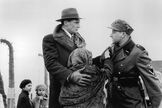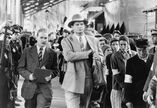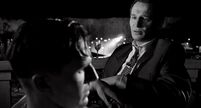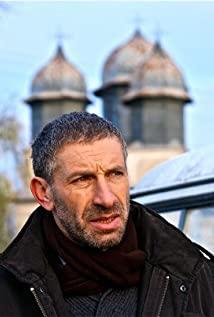First, if you want to make the audience cry, you must first move the audience
Who will we shed tears for? A person we have never heard of died far away from us. Will you shed tears? CCTV news often reports that the leader has passed away. I am mostly insensitive. It's not that I am not patriotic. I don't know him after all. People are emotional animals and don't know how to be sad, so if you want the audience to cry for the character, you must make the audience have a deep impression of the character. There are more than 120 characters in "Schindler's List". Although the audience may not remember all of them, it is not a problem to remember 20 or 30. Give some supporting examples: the maid Helen; the Jewish female engineer The little girl with glasses and her mother; the clever little boy; the one-armed grandfather; the little girl in red, etc., each impressed the audience like an acquaintance, and even when they are in danger The audience will definitely be sad when they are killed.
The first person killed by the Nazis in the movie is the one-armed grandfather. Spielberg will not "kill the innocent". The death of the one-armed old man opened the prelude to the massacre. Let's take a look at how the choreographer created the image of a simple and ignorant one-armed old man, and made the audience feel emotional and even cry for it. This is the first time Spielberg has shown his cruelty in this film. What kind of role can move people the most? Is it the kind of person who has no shortcomings and is almost perfect? Not necessarily, sometimes the existence of minor shortcomings and minor problems strengthens the role. Our domestic movies are different. It must be distinguished between good and evil. The bad guys must be broken to the bone, and the good guys must be tall and stalwart. This is actually boring. Now the main theme of the domestic anti-war drama is so positive. The characters are so upright that the audience is unconvinced. The Jews in this film are honest and sincere, ignorant and servile. Such a person makes people sympathetic. Like the one-armed old man, he makes people feel very real because he is grounded.
The protagonist Schindler is eating, and the secretary tells him that someone wants to see him to show his gratitude. This scene is used to portray the image of the one-armed old man. Schindler was already very upset when he saw that the other party was disabled, but he hadn't shown it on his face. The one-armed old man was very unaware and verbose, and he spoke and hesitated, so at last Schindler simply sat on the chair and turned his face. Turning aside and letting the old man talk, the atmosphere is funny and embarrassing. Although Schindler did not say a single line of dissatisfaction, the composition and performance betrayed his heart. The composition of this scene is very exciting. The subtext is expressed through the composition. Since the film is a black and white film, the contrast of colors has been lost, so The requirements for composition and lighting are even higher.
After the old man left, the camera gave Schindler again. This was a quiet field and the atmosphere was very embarrassing. Schindler's dissatisfaction suddenly appeared on the screen. Schindler felt that such disabled people shouldn't enter his factory, and his face was sour that he didn't even want to talk to the secretary. This is to further strengthen the image of the old man and Schindler to pave the way for the next turning point. It was precisely because of this meeting that the audience and Schindler both remembered this honest old man and felt sorry for his death. It was also the death of the Jews who made Schindler love and hate. The conscience of this "jerk" made him determined to save these "lower" Jews. In addition, the choreographer also spent a lot of effort to shape many similar characters, so that they have flesh and blood, the purpose is obvious: fatten up and kill! Only when the audience sympathizes with the character themselves, they will sympathize with the character's experience. After talking about this grandfather, let's look at a massacre. In this scene, the grim and cruel scene of Lao Si is outrageous. Those who watch it can't help but say: Spielberg This trick is too detrimental and too poisonous. At a certain time, the concentration camp will conduct a physical examination to screen some people, and the survival of the fittest will send them to Auschwitz. This scene is very shocking. Spielberg asked a group of children to hold hands and sing songs happily into the picture, surrounded by Nazi officers and soldiers, the result is self-evident, these bright smiling children are to be sent to Auschwitz, Laos is the most boring. It is to let the children hold hands and sing songs to death. The more lovely and innocent the children show, the more sympathy the audience will be. The contrast between the children’s ignorance and innocence and the door of hell that is about to open is a shocking effect. Metaphor.
When the children got into the car, they still laughed and laughed, forming a second contrast with the parents who were crying and chasing the car behind. Thousands of parents chased the car and called their children’s names. The children in the car laughed ignorantly. Parents say hello. Parents cry because they know the car is a hearse for their children, and children laugh only because they see their parents. This scene of Spielberg’s sorrowful arrival at home, tearing the audience’s hearts to pieces, the children’s innocence and cuteness made the audience sympathize, and the parents’ cries once again drove the audience’s emotions. In this scene, both parents and the audience know it. Only the children do not know the fate that children will face, which creates dramatic tension. This scene is extremely cruel. It is not the cruelty of the director and screenwriter but the cruelty of history. Spielberg completed the memorial to life and the strongest accusation of atrocities through the smiling faces of the children. As I said earlier, Laos His cruelty is a manifestation of his great love and warmth. If he did not respect these young creatures but went to the box office completely, then he would never be able to shoot such a direct shot of the heart. There are many examples of this in the movie. . The movie did not show the following picture, but the result is self-evident, and not showing this picture is far more powerful than the shocking effect brought by the show! This is the second point I want to make:
Second, what is invisible is far more contagious than what is visible
In this film, there are many scenes that face violence, but more of the massacre Spielberg is represented by profile description, which avoids vulgar blood and further deepens the shock. A major feature of Old Si's movies is that he likes to omit the process of violence and directly show the results of violence. For example, when the Nazis were about to bloodbath the Jewish quarter, a large number of Jews were sent on the train to Auschwitz. After the train is gone, the camera does not take pictures of the Jews, but uses a series of shots to show the objects they left behind: piles of suitcases, leather shoes, accessories and even teeth, toy dolls and pictures of Jews. It is to poke the audience's heart.
A photo is a magical thing. It can freeze the time. In the movie, when the lens skips a picture, although it is a long shot, it has a special montage effect . A few pictures can give a glimpse of a person’s life, such as "Citizen Kai "Yes", such as the photo of Ruth's life at the end of "Titanic". Objects before a lifetime are the images that can best express the vitality of a character during his lifetime, and are also the things that can most arouse people's feelings . As the so-called seeing things and thinking about people, E Fat is right: "Your backpack makes me walk so slowly." Such a highly realistic scene combined with the sad music of John Williams made the whole scene sad to the bone. Spielberg's ability to shoot such a scene also originated from the accumulation of life. The next massacre scene Spielberg made the audience face violence. , But did not face the violence directly, still let the invisible things work, cruelly abnormal. The atmosphere of this crazy slaughter is also superb, focusing on the analysis: when the moon is dark and the wind is high at night, when the killing is overwhelming. In the elegant and melancholic symphony, a pair of Nazi officers and soldiers ran into the picture. The lighting in this scene was very particular. The lights came from the side. The officers’ helmets were shining in the night, but we couldn’t see their faces, which made the Nazis look even more. fear;
After the noisy footsteps, the camera cut into the room and the music disappeared. The room was surprisingly quiet and it was an auditory contrast with just now. The Nazi officers and soldiers searched every corner with their stethoscopes, and the soldiers stood ready with submachine guns in their hands. This is a set of parallel montages. On one side, the Nazis lead the snake out of the cave, and on the other, the Jewish people who wished to get the bait came out of the hiding place. In this scene, the environmental sound played a huge role. The soundtrack was very soft and almost non-existent, highlighting the role of the environmental sound. The cicadas are noisy and quiet, which is to highlight the quiet atmosphere in the room. The officers and soldiers walked around the room with flashlights and stepped on the floor to make a clattering sound to make the room more quiet. The quieter the sound in danger, the more breathtaking the atmosphere . This is the habit of horror thrillers. The technique , Spielberg is the thriller that started the atmosphere to control the natural mastery. Next, a Nazi found a person hidden under the bed. This line reached a climax. The climax of the parallel montage happened at the same time. A Jew who was hiding in the piano accidentally touched the keys of the piano when he came out of the piano, exposing himself. The other two groups of officers and soldiers also found the target, and this line reached its climax. In a flash, the whole building burst into flames.
At this time Spielberg was sullen again. The audience was not allowed to watch the killing screen but the audience was allowed to listen to the shouts and gunshots. What was even more sorrowful was that someone was playing the piano! This must be the piano that the Jew accidentally touched just now. Who is so perverted? The cheerful sound of the piano was mixed with the sounds of the guns and the shouts of the soldiers and Jews. The scene flickered against the fire, but the audience just couldn't see the scene of the killing. Then the camera cut to the room with the piano. Here, an officer is playing the piano gracefully, and gunshots burst into flames outside the room. This killing is a carnival in the eyes of the officer.
The camera cuts to the street. There are mountains of corpses on the street. The Nazi major played by Ralph Fiennes sits and washes his face, complaining that he has been killed for a day and is exhausted. The windows of the building behind him flickered and the piano sound continued, followed by a large panoramic view. The whole block was full of gunfire. The windows of the street building flickered and flickered, although the audience did not directly see the picture. The shock is definitely more than twice that of confronting violence, and the cheerful piano sound is estimated to be hated by the audience. (The window behind the major is flickering and dimming. This trick is also used in the American drama "Ice Blood Storm" and is more forceful)
This kind of technique was another time when the major killed his own manservant, and the atmosphere was even more terrifying than this time, and it also showed the third feature of Spear's forced movie:
Third, give you hope, and then smash it completely
This trick is the cruelest thing about Lao Si, it is to tell you clearly that the miracle in that era of despair is just a beautiful fantasy. Take this manservant as an example: The major played by Ralph Fiennes is a cold-blooded almost abnormal man who treats Jews. In order to perform this cruel and vicious Ralph Feinster, he repaired his eyebrows and had to do it every time before shooting. Drink spirits to "enjoy". Schindler's theory of persuading majors to kill less is classic: a person commits a capital crime and we kill him is not called power, it is called sanctions. A person commits a capital crime, but we forgive him is called power. The major had listened to Schindler's advice, and sure enough, there were fewer killings. His footman made many mistakes, and the major held back his anger and pardoned him. But this is only temporary, and the devil will not be called a devil if he is not cruel. The footman Rišek made a mistake again. The major was very angry. Rišek was trembling with fear. The major pardoned him again, but the scene did not end. The mood and mood kept improving : on the one hand, Rišek was walking on the playground, and on the other. The major in the room murmured and repeated what had just been said. The shots were switched repeatedly, the major's emotions were accumulating, and the audience knew that the danger was brewing. Then a close-up of the major's face had terrifying eyes and a surprisingly quiet voice.
Suddenly, when a gun was fired, Lišek was taken aback, but he didn't know where the gun was fired, so he continued on. There was another gunshot with a huge echo, and several people on the playground were scared away, and Rišek continued to walk forward. At this time, Spielberg took the sorrowful line again, insisting on letting the invisible things work, eliminating the process of violence and directly showing the results. The camera cuts to Schindler's accountant. Schindler's accountant is walking on the playground and there is another huge gunshot. The accountant continued to move forward, the camera followed the accountant, and then we saw the blood-filled body of the male servant, which was a sudden attack and want to catch. (Kill the footman)
The violence broke out suddenly, and Spielberg prevented us from seeing the shot of the male servant falling to the ground, but the atmosphere created was so tense to suffocate that was far more shocking than deliberately vulgar and bloody. Some domestic directors don’t know if it’s a psychological perversion. They are perverted solely for the sake of pervertedness. In order to highlight the cruelty of the Japanese army, they deliberately worked hard on vulgarity and violence. What I want to ask is that the Japanese army burns, kills, commits crimes and commits crimes. Are you trying to insult women by the Japanese army? Only by taking detailed shots can you show your humanistic feelings and show the cruelty of the Japanese army. As a result, the shots made people can't bear to watch or even ashamed to watch, only to see the director's vulgar taste and completely invisible to the compassion for humanity. Maybe they are very careful when shooting, but they have forgotten the most important point: it is never the visual shock that touches the audience. The atmosphere behind the vision and the emotions that represent it will cause the greatest psychological impact on the audience. You put one The audience was really taken aback by the bloody picture, but they would soon forget and could not inspire the audience to sympathize with the character; and if you emotionally impressed the audience and abused him, he will remember it for a long time . Hitchcock was right: the real horror is not the disgusting way of death but the emotions brewing before death.Just like the slaughter village at the end of "The Devil Is Coming", with the huge irony in the plot and the atmosphere and emotional climax, the ignorant villagers are now suddenly realized but have no chance. The impact on the audience is almost immersed in the audience. The environment is general, as if the audience is being slaughtered. Killing the footman tells the audience that there is no miracle, but this is just the beginning. Spielberg weaves a beautiful lie for the audience at the beginning of the massacre, and then smashes it to pieces. This is the most cruel passage in the whole film. In "Schindler's List", what impressed the audience the most was the girl in red in the black and white video. The child is the image of Spielberg’s continued high hopes. In Spielberg’s movies, the child is an ideal carrier of innocence, beauty, innocence and kindness, whether it is the "Third Kind of Contact", "ET" or the upcoming "Spy Bridge" "All have children. The girl in red in this film can be regarded as the most memorable image of a child in Lao Si's movie. In the middle of the massacre, the girl in red appeared on the stage. She hobbled very cutely. In the black-and-white film shots, red became the only bright color, so it was particularly conspicuous. When the girl came on stage, the music played. This music was a group of children. The chorus is as solemn and sacred as the hymn of Christ, making the little girl like an angel. On the side of the mountain, Schindler looked down on the street down the mountain and saw the girl in red. Maybe it was the girl who hit Schindler's heart, and Schindler was determined to save the Jews. The girl is walking on the street, and the ghosts and wolves are full of killing. The unique design of this scene makes the audience think that this is a beautiful fantasy the director puts in despair, it is a hope for the audience, the director's tribute to life, and a beacon in the dark . In this regard, Mengsao's Spielberg expressed ha ha. The girl hopped up to a loft, got under the bed, and made a humming sound when she got in. The girl under the bed didn't like the noise outside, so she covered her ears and widened her eyes. Looking outside with a cute face, this scene is cute enough.
But if you are more careful, you will find that the picture becomes black and white after the girl gets under the bed. The voice-over is the sound of a large group of people running. Whose voice is this sound? This is a trick played by the director on transitions: sound transitions. I analyzed this technique in the "Alive" film review, and also specifically emphasized that it has been used many times in "Schindler's List". This team is the one that focused on slaughtering residents at night. The director used his voice to move directly from inside the house during the day to outside the house at night. The officers and soldiers searched floor by floor with stethoscopes, not even the beds and cabinets. The fate of the girl is self-evident. In the script, the producers are also deliberately trying to get rid of it, and writing with reverse thinking is also obliterating the audience's hope. On a train bound for Auschwitz, the passengers were so thirsty that Schindler wanted to help them, so they borrowed water pipes and said that they were making fun of the people in the carriage, but they were actually giving them water. Everyone looked at Schindler. He sprayed water on the train and laughed, thinking that Schindler was too bad for fun. Just as the audience was moved by Schindler’s good deeds, the major suddenly said: "Schindler, you are too cruel. Give them hope!" (Schindler sprays water on the train to help the Jews)
This kind of reverse thinking suddenly poured cold water on the audience. No matter what, these people were all dead when they arrived in Auschwitz. Schindler thought he was saving them. In fact, not only could it not save them, but it only increased them before death. s pain. And the last shot of this scene is a single close-up shot of the major. The major’s frowning brows and stern faces also tell the audience that the major has already seen Schindler’s intentions, and this reverse thinking scene is also A magical pen is not found in other movies of this subject. The difficulty of shooting "Schindler's List" is mainly due to the particularity of the subject matter. Historical themes and biopics are the most difficult to shoot in all genres. One of the difficulties is the creation of the script: respect for historical facts and have a dramatic finality. They must also be able to express the thoughts they want to express. Biopics are similar to historical themes but different from historical themes. The creation of scripts is also very difficult, but these two themes are the best carriers for filmmakers to express their humanistic thoughts and think about life. Therefore, it is favored by directors and academics, and it is Oscar's favorite taste. Those who are not skilled enough to control these two themes are either made into documentary films, or into niche fan films, or works like tasteless works are meaningless. In recent years, these kinds of works have been produced almost endlessly and have no value except for money. , Will soon be completely forgotten by movie fans, so it is very difficult for history and biography to shoot well or even to shoot depth. And this film as a historical biographical film can be said to be even more difficult. "Schindler's List" took 13 years from planning to filming. The main time was spent on script creation, fundraising and the establishment of the crew. The script was revised several times and changed hands. Many merchants are not keen on this kind of subject matter. Finally, Universal Pictures The premise of the company's decision to invest is that Spielberg is the director of "Jurassic Park", and Lao Si's filming of "Jurassic Park" has created a box office miracle before gaining the absolute right to speak in "Schindler's List". "Schindler's List" is 195 minutes long. Almost all black and white images are used in the film. It is an anti-market work, but it has won the support of major theaters and eventually won more than 300 million U.S. dollars in box office worldwide. The director and producer Spielberg donated all the box office proceeds to the Jewish Holocaust Memorial for free. The greatness of "Schindler's List" is not only related to its ideology and historical events it reflects, but also to its superb artistic level. There are many movies on this subject, but "Schindler's List" only has one. The film is impeccable in terms of the director’s skills, the script, and the pictures, especially the art design of "Schindler's List" is comparable to "Titanic" or even better. Although "Schindler's List" is black and white The picture but the scene is extremely gorgeous and beautifully composed, making the movie appear black and white The picture looks pleasing to the eye, and it is basically unbearable to close as soon as it is opened. This is also one of the characteristics of Spielberg's movies: the exquisite picture is called a photography and art textbook. This is how great movies should be. Not only are their thoughts and deep emotions moving, but their superb techniques have an important reference value for film apprentices. Such movies have a high status in the hearts of ordinary fans and academics, and such movies can be handed down to the world.
If you haven’t watched a movie, then you should really look for it. This is not a depressing movie. On the contrary, this is a movie full of humanity and warmth. Although Spielberg’s methods are cold and cruel, they are all It is to set off humanity. This is all out of his respect for life. The massacre is only the historical background of the film. The discussion of humanity under history is the main theme of this film. The focus of the film is on characterization, whether it is The daunting major murder; the servile and kind-hearted Jew; or the shameless bastard, director Schindler treats them as a person, and then walks into their inner world during the special period of World War II. For example, the major is cruel. But he will also be emotional, and he will also fall in love with his Jewish maid. This plot setting not only enriches the character of the major, but is also the best attack on racial discrimination, although this major in history simply cannot be like this. In short, "Schindler's List" is a desperate movie that gives people endless warmth. After watching it, it makes people feel comfortable rather than depressed and sad. Such a heavy theme can be emotionally affected by Spielberg. It is not easy to grasp it so well.
View more about Schindler's List reviews











